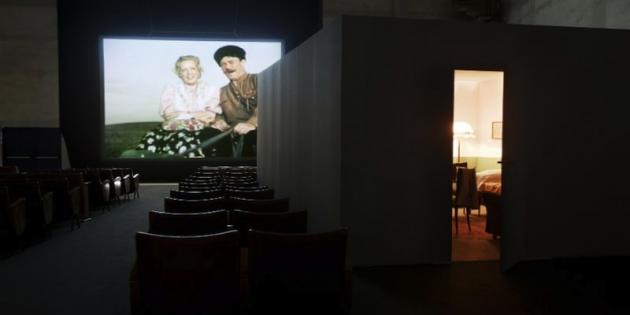The cavernous, industrial Ambika P3, a space designed to test structural concrete has been turned over to the celebrated Russian artists Ilya and Emilia Kabakov for the next few weeks.
As influential pioneers of installation art, ‘The Happiest Man’ is one of the most ambitious politically motivated works ever shown in London. The piece depicts the inside an empty cinema and projects loops of technicolored films depicting an idealised memory of Soviet-era Russia. The sentiment conveys a romanticised vision of propaganda fuelled workers performing a number of respectable everyday tasks. On one side of the space, a small single room ‘workers house’ sits, the empty lounge is set for teatime, a prominent single bed is in view and a window looks out onto the cinema screen, creating the only view from the house. The installation explores the subtile boundaries between imagination, nostalgia and art set against a backdrop of the grim reality that was post-Stalinist Russia.
lya and Emilia Kabakov are Russian-born, American-based artists that collaborate on environments which fuse elements of the everyday with those of the conceptual. While their work is deeply rooted in the Soviet social and cultural context in which the Kabakovs came of age, their work still attains a universal significance.
Ilya Kabakov was born in Dnepropetrovsk, Soviet Union, in 1933. He studied at the VA Surikov Art Academy in Moscow, and began his career as a children’s book illustrator during the 1950’s. He was part of a group of Conceptual artists in Moscow who worked outside the official Soviet art system. In 1985 he received his first solo show exhibition at Dina Vierny Gallery, Paris, and he moved to the West two years later taking up a six months residency at Kunstverein Graz, Austria. In 1988 Kabakov began working with his future wife Emilia (they were to be married in 1992). From this point onwards, all their work was collaborative, in different proportions according to the specific project involved. Today Kabakov is recognized as the most important Russian artist to have emerged in the late 20th century. His installations speak as much about conditions in post-Stalinist Russia as they do about the human condition universally.

